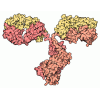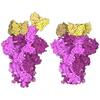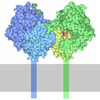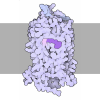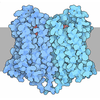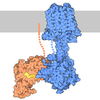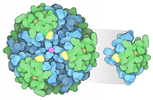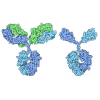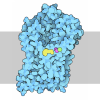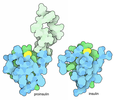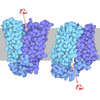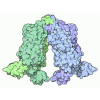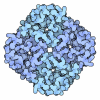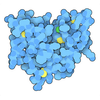+ データを開く
データを開く
- 基本情報
基本情報
| 登録情報 | データベース: PDB / ID: 8sg1 | |||||||||||||||||||||||||||||||||||||||||||||
|---|---|---|---|---|---|---|---|---|---|---|---|---|---|---|---|---|---|---|---|---|---|---|---|---|---|---|---|---|---|---|---|---|---|---|---|---|---|---|---|---|---|---|---|---|---|---|
| タイトル | Cryo-EM structure of CMKLR1 signaling complex | |||||||||||||||||||||||||||||||||||||||||||||
 要素 要素 |
| |||||||||||||||||||||||||||||||||||||||||||||
 キーワード キーワード | SIGNALING PROTEIN / GPCR / Peptide agonist / Chemerin9 / Membrane protein | |||||||||||||||||||||||||||||||||||||||||||||
| 機能・相同性 |  機能・相同性情報 機能・相同性情報adipokinetic hormone binding / adipokinetic hormone receptor activity / complement receptor activity / chemokine receptor activity / negative regulation of interleukin-12 production / complement receptor mediated signaling pathway / Class A/1 (Rhodopsin-like receptors) / negative regulation of NF-kappaB transcription factor activity / positive regulation of macrophage chemotaxis / positive regulation of fat cell differentiation ...adipokinetic hormone binding / adipokinetic hormone receptor activity / complement receptor activity / chemokine receptor activity / negative regulation of interleukin-12 production / complement receptor mediated signaling pathway / Class A/1 (Rhodopsin-like receptors) / negative regulation of NF-kappaB transcription factor activity / positive regulation of macrophage chemotaxis / positive regulation of fat cell differentiation / adenylate cyclase inhibitor activity / positive regulation of protein localization to cell cortex / T cell migration / Adenylate cyclase inhibitory pathway / D2 dopamine receptor binding / response to prostaglandin E / adenylate cyclase regulator activity / G protein-coupled serotonin receptor binding / regulation of calcium-mediated signaling / adenylate cyclase-inhibiting serotonin receptor signaling pathway / cellular response to forskolin / regulation of mitotic spindle organization / skeletal system development / Regulation of insulin secretion / positive regulation of cholesterol biosynthetic process / negative regulation of insulin secretion / G protein-coupled receptor binding / G protein-coupled receptor activity / response to peptide hormone / adenylate cyclase-inhibiting G protein-coupled receptor signaling pathway / adenylate cyclase-modulating G protein-coupled receptor signaling pathway / G-protein beta/gamma-subunit complex binding / centriolar satellite / Olfactory Signaling Pathway / Activation of the phototransduction cascade / G beta:gamma signalling through PLC beta / Presynaptic function of Kainate receptors / Thromboxane signalling through TP receptor / G protein-coupled acetylcholine receptor signaling pathway / Activation of G protein gated Potassium channels / Inhibition of voltage gated Ca2+ channels via Gbeta/gamma subunits / G-protein activation / chemotaxis / Prostacyclin signalling through prostacyclin receptor / G beta:gamma signalling through CDC42 / Glucagon signaling in metabolic regulation / G beta:gamma signalling through BTK / Synthesis, secretion, and inactivation of Glucagon-like Peptide-1 (GLP-1) / ADP signalling through P2Y purinoceptor 12 / photoreceptor disc membrane / Sensory perception of sweet, bitter, and umami (glutamate) taste / Glucagon-type ligand receptors / Adrenaline,noradrenaline inhibits insulin secretion / Vasopressin regulates renal water homeostasis via Aquaporins / GDP binding / Glucagon-like Peptide-1 (GLP1) regulates insulin secretion / G alpha (z) signalling events / cellular response to catecholamine stimulus / ADP signalling through P2Y purinoceptor 1 / ADORA2B mediated anti-inflammatory cytokines production / G beta:gamma signalling through PI3Kgamma / adenylate cyclase-activating dopamine receptor signaling pathway / Cooperation of PDCL (PhLP1) and TRiC/CCT in G-protein beta folding / GPER1 signaling / Inactivation, recovery and regulation of the phototransduction cascade / cellular response to prostaglandin E stimulus / G-protein beta-subunit binding / heterotrimeric G-protein complex / G alpha (12/13) signalling events / sensory perception of taste / extracellular vesicle / signaling receptor activity / signaling receptor complex adaptor activity / Thrombin signalling through proteinase activated receptors (PARs) / positive regulation of cold-induced thermogenesis / retina development in camera-type eye / G protein activity / positive regulation of cytosolic calcium ion concentration / GTPase binding / Ca2+ pathway / fibroblast proliferation / midbody / High laminar flow shear stress activates signaling by PIEZO1 and PECAM1:CDH5:KDR in endothelial cells / cell cortex / G alpha (i) signalling events / G alpha (s) signalling events / phospholipase C-activating G protein-coupled receptor signaling pathway / G alpha (q) signalling events / 加水分解酵素; 酸無水物に作用; GTPに作用・細胞または細胞小器官の運動に関与 / Ras protein signal transduction / Extra-nuclear estrogen signaling / cell population proliferation / immune response / ciliary basal body / G protein-coupled receptor signaling pathway / inflammatory response / lysosomal membrane / cell division / GTPase activity / synapse 類似検索 - 分子機能 | |||||||||||||||||||||||||||||||||||||||||||||
| 生物種 |  Homo sapiens (ヒト) Homo sapiens (ヒト) | |||||||||||||||||||||||||||||||||||||||||||||
| 手法 | 電子顕微鏡法 / 単粒子再構成法 / クライオ電子顕微鏡法 / 解像度: 2.94 Å | |||||||||||||||||||||||||||||||||||||||||||||
 データ登録者 データ登録者 | Zhang, X. / Zhang, C. | |||||||||||||||||||||||||||||||||||||||||||||
| 資金援助 |  米国, 1件 米国, 1件
| |||||||||||||||||||||||||||||||||||||||||||||
 引用 引用 |  ジャーナル: PLoS Biol / 年: 2023 ジャーナル: PLoS Biol / 年: 2023タイトル: Structural basis of G protein-Coupled receptor CMKLR1 activation and signaling induced by a chemerin-derived agonist. 著者: Xuan Zhang / Tina Weiß / Mary Hongying Cheng / Siqi Chen / Carla Katharina Ambrosius / Anne Sophie Czerniak / Kunpeng Li / Mingye Feng / Ivet Bahar / Annette G Beck-Sickinger / Cheng Zhang /   要旨: Chemokine-like receptor 1 (CMKLR1), also known as chemerin receptor 23 (ChemR23) or chemerin receptor 1, is a chemoattractant G protein-coupled receptor (GPCR) that responds to the adipokine chemerin ...Chemokine-like receptor 1 (CMKLR1), also known as chemerin receptor 23 (ChemR23) or chemerin receptor 1, is a chemoattractant G protein-coupled receptor (GPCR) that responds to the adipokine chemerin and is highly expressed in innate immune cells, including macrophages and neutrophils. The signaling pathways of CMKLR1 can lead to both pro- and anti-inflammatory effects depending on the ligands and physiological contexts. To understand the molecular mechanisms of CMKLR1 signaling, we determined a high-resolution cryo-electron microscopy (cryo-EM) structure of the CMKLR1-Gi signaling complex with chemerin9, a nanopeptide agonist derived from chemerin, which induced complex phenotypic changes of macrophages in our assays. The cryo-EM structure, together with molecular dynamics simulations and mutagenesis studies, revealed the molecular basis of CMKLR1 signaling by elucidating the interactions at the ligand-binding pocket and the agonist-induced conformational changes. Our results are expected to facilitate the development of small molecule CMKLR1 agonists that mimic the action of chemerin9 to promote the resolution of inflammation. | |||||||||||||||||||||||||||||||||||||||||||||
| 履歴 |
|
- 構造の表示
構造の表示
| 構造ビューア | 分子:  Molmil Molmil Jmol/JSmol Jmol/JSmol |
|---|
- ダウンロードとリンク
ダウンロードとリンク
- ダウンロード
ダウンロード
| PDBx/mmCIF形式 |  8sg1.cif.gz 8sg1.cif.gz | 238.3 KB | 表示 |  PDBx/mmCIF形式 PDBx/mmCIF形式 |
|---|---|---|---|---|
| PDB形式 |  pdb8sg1.ent.gz pdb8sg1.ent.gz | 183 KB | 表示 |  PDB形式 PDB形式 |
| PDBx/mmJSON形式 |  8sg1.json.gz 8sg1.json.gz | ツリー表示 |  PDBx/mmJSON形式 PDBx/mmJSON形式 | |
| その他 |  その他のダウンロード その他のダウンロード |
-検証レポート
| 文書・要旨 |  8sg1_validation.pdf.gz 8sg1_validation.pdf.gz | 1.5 MB | 表示 |  wwPDB検証レポート wwPDB検証レポート |
|---|---|---|---|---|
| 文書・詳細版 |  8sg1_full_validation.pdf.gz 8sg1_full_validation.pdf.gz | 1.5 MB | 表示 | |
| XML形式データ |  8sg1_validation.xml.gz 8sg1_validation.xml.gz | 40.8 KB | 表示 | |
| CIF形式データ |  8sg1_validation.cif.gz 8sg1_validation.cif.gz | 61.2 KB | 表示 | |
| アーカイブディレクトリ |  https://data.pdbj.org/pub/pdb/validation_reports/sg/8sg1 https://data.pdbj.org/pub/pdb/validation_reports/sg/8sg1 ftp://data.pdbj.org/pub/pdb/validation_reports/sg/8sg1 ftp://data.pdbj.org/pub/pdb/validation_reports/sg/8sg1 | HTTPS FTP |
-関連構造データ
| 関連構造データ |  40450MC M: このデータのモデリングに利用したマップデータ C: 同じ文献を引用 ( |
|---|---|
| 類似構造データ | 類似検索 - 機能・相同性  F&H 検索 F&H 検索 |
- リンク
リンク
- 集合体
集合体
| 登録構造単位 | 
|
|---|---|
| 1 |
|
- 要素
要素
-Guanine nucleotide-binding protein ... , 3種, 3分子 BGA
| #2: タンパク質 | 分子量: 36956.383 Da / 分子数: 1 / 由来タイプ: 組換発現 / 由来: (組換発現)  Homo sapiens (ヒト) / 遺伝子: GNB1 Homo sapiens (ヒト) / 遺伝子: GNB1発現宿主:  参照: UniProt: P62873 |
|---|---|
| #3: タンパク質 | 分子量: 6000.000 Da / 分子数: 1 / 由来タイプ: 組換発現 / 由来: (組換発現)  Homo sapiens (ヒト) / 遺伝子: GNG2 Homo sapiens (ヒト) / 遺伝子: GNG2発現宿主:  参照: UniProt: P59768 |
| #4: タンパク質 | 分子量: 40122.660 Da / 分子数: 1 / Mutation: S47N, G203A, E245A, A326S / 由来タイプ: 組換発現 / 由来: (組換発現)  Homo sapiens (ヒト) / 遺伝子: GNAI1 Homo sapiens (ヒト) / 遺伝子: GNAI1発現宿主:  参照: UniProt: P63096 |
-タンパク質 / タンパク質・ペプチド / 抗体 , 3種, 3分子 RLE
| #1: タンパク質 | 分子量: 33079.715 Da / 分子数: 1 / 由来タイプ: 組換発現 / 由来: (組換発現)  Homo sapiens (ヒト) / 遺伝子: CMKLR1 Homo sapiens (ヒト) / 遺伝子: CMKLR1発現宿主:  参照: UniProt: Q99788 |
|---|---|
| #5: タンパク質・ペプチド | 分子量: 1063.161 Da / 分子数: 1 / 由来タイプ: 合成 / 由来: (合成)  Homo sapiens (ヒト) Homo sapiens (ヒト) |
| #6: 抗体 | 分子量: 28634.797 Da / 分子数: 1 / 由来タイプ: 組換発現 / 由来: (組換発現)  発現宿主:  |
-非ポリマー , 2種, 3分子 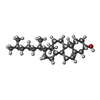


| #7: 化合物 | ChemComp-CLR / |
|---|---|
| #8: 化合物 |
-詳細
| 研究の焦点であるリガンドがあるか | Y |
|---|---|
| Has protein modification | Y |
-実験情報
-実験
| 実験 | 手法: 電子顕微鏡法 |
|---|---|
| EM実験 | 試料の集合状態: PARTICLE / 3次元再構成法: 単粒子再構成法 |
- 試料調製
試料調製
| 構成要素 | 名称: Chemerin9-CMKLR1-Gi complex / タイプ: COMPLEX / Entity ID: #1-#6 / 由来: MULTIPLE SOURCES |
|---|---|
| 分子量 | 実験値: NO |
| 由来(天然) | 生物種:  |
| 由来(組換発現) | 生物種:  Baculovirus expression vector pFastBac1-HM (ウイルス) Baculovirus expression vector pFastBac1-HM (ウイルス) |
| 緩衝液 | pH: 7.5 |
| 試料 | 包埋: NO / シャドウイング: NO / 染色: NO / 凍結: YES |
| 急速凍結 | 凍結剤: ETHANE |
- 電子顕微鏡撮影
電子顕微鏡撮影
| 実験機器 |  モデル: Titan Krios / 画像提供: FEI Company |
|---|---|
| 顕微鏡 | モデル: FEI TITAN KRIOS |
| 電子銃 | 電子線源:  FIELD EMISSION GUN / 加速電圧: 300 kV / 照射モード: FLOOD BEAM FIELD EMISSION GUN / 加速電圧: 300 kV / 照射モード: FLOOD BEAM |
| 電子レンズ | モード: BRIGHT FIELD / 最大 デフォーカス(公称値): 1800 nm / 最小 デフォーカス(公称値): 1000 nm |
| 撮影 | 電子線照射量: 56 e/Å2 フィルム・検出器のモデル: GATAN K3 BIOQUANTUM (6k x 4k) |
- 解析
解析
| EMソフトウェア | 名称: PHENIX / カテゴリ: モデル精密化 |
|---|---|
| CTF補正 | タイプ: PHASE FLIPPING AND AMPLITUDE CORRECTION |
| 3次元再構成 | 解像度: 2.94 Å / 解像度の算出法: FSC 0.143 CUT-OFF / 粒子像の数: 242745 / 対称性のタイプ: POINT |
 ムービー
ムービー コントローラー
コントローラー



 PDBj
PDBj